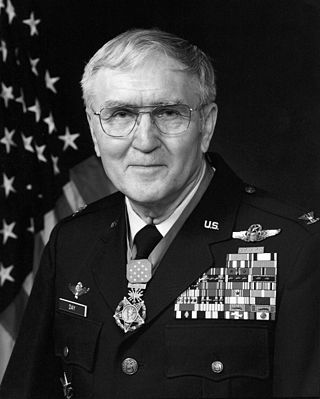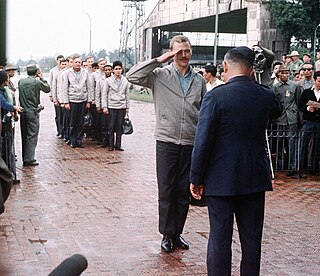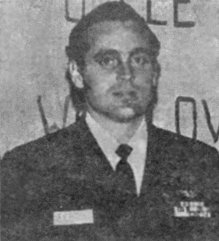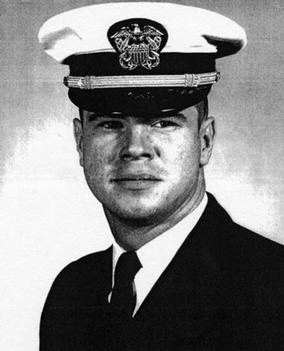
Hỏa Lò Prison was a prison in Hanoi originally used by the French colonists in Indochina for political prisoners, and later by North Vietnam for U.S. prisoners of war during the Vietnam War. During this later period, it was known to American POWs as the "Hanoi Hilton". Following Operation Homecoming, the prison was used to incarcerate Vietnamese dissidents and other political prisoners, including the poet Nguyễn Chí Thiện. The prison was demolished during the 1990s, although its gatehouse remains a museum.

James Bond "Jim" Stockdale was a United States Navy vice admiral and aviator who was awarded the Medal of Honor in the Vietnam War, during which he was a prisoner of war for over seven years.

Jeremiah Andrew Denton Jr. was an American politician and military officer who served as a U.S. Senator representing Alabama from 1981 to 1987. He was the first Republican to be popularly elected to a Senate seat in Alabama. Denton was previously a United States Navy rear admiral and naval aviator taken captive during the Vietnam War.

William Porter "Bill" Lawrence was a decorated United States Navy vice admiral and Naval Aviator who served as Superintendent of the United States Naval Academy from 1978 to 1981. Lawrence was a noted pilot, the first Naval Aviator to fly twice the speed of sound in a naval aircraft, and one of the final candidates for the Mercury space program. During the Vietnam War, Lawrence was shot down while on a combat mission and spent six years as a prisoner of war, from 1967 to 1973. During this time, he became noted for his resistance to his captors.

George Thomas Coker is a retired United States Navy commander who was awarded the Navy Cross for extraordinary heroism as a prisoner of war (POW) during the Vietnam War. An Eagle Scout, he is noted for his devotion to Scouting.

George Everette "Bud" Day was a United States Air Force officer, aviator, and veteran of World War II, Korean War and Vietnam War. He was also a prisoner of war, and recipient of the Medal of Honor and Air Force Cross. As of 2016, he is the only person to be awarded both the Medal of Honor and Air Force Cross. He was posthumously advanced to the rank of brigadier general effective March 27, 2018, as directed by the 2017 National Defense Authorization Act.
Nguyễn Chí Thiện was a North Vietnamese dissident, activist and poet who spent a total of twenty-seven years as a political prisoner of the communist regimes of both North Vietnam and of post-1975 Vietnam, before being released and allowed to join the large Overseas Vietnamese community in the United States.

Operation Homecoming was the return of 591 American prisoners of war (POWs) held by North Vietnam following the Paris Peace Accords that ended U.S. involvement in the Vietnam War.

Eugene Barker McDaniel is a retired United States Navy captain, Naval Aviator and a prisoner of war during the Vietnam War. He was released from captivity on 4 March 1973 after six years of confinement.
The early life and military career of John Sidney McCain III spans the first forty-five years of his life (1936–1981). McCain's father and grandfather were admirals in the United States Navy. McCain was born on August 29, 1936, in the Panama Canal Zone, and attended many schools growing up as his family moved among naval facilities. McCain graduated from the United States Naval Academy in 1958. He married the former Carol Shepp in 1965; he adopted two children from her previous marriage and they had another child together.

Faith of My Fathers is a 2005 American biographical drama television film directed by Peter Markle and written by Markle and William Bingham, based on the 1999 memoir of the same name by United States Senator and former United States Navy aviator John McCain. It aired on A&E on Memorial Day, May 30, 2005.

John Arthur Dramesi was a United States Air Force (USAF) colonel who was held as a prisoner of war from 2 April 1967 to 4 March 1973 in both Hoa Lo Prison, known as "The Hanoi Hilton", and Cu Loc Prison, "The Zoo", during the Vietnam War.

John Heaphy "Jack" Fellowes was a U.S. Navy captain, pilot who became a prisoner of war (POW) during the Vietnam War. He was known as "Happy Jack" because of his infectious sense of humor, which he maintained even while a POW. He was awarded the Silver Star for his "conspicuous gallantry and intrepidity" while a POW, credited with "contributed significantly toward the eventual abandonment of harsh treatment by the North Vietnamese".
Richard Allen Stratton is a retired Naval Aviator and a clinical social worker. He served as lieutenant commander during the Vietnam War from 1966 to 1973. He served on the USS Ticonderoga (CVA-14)/Air Wing 19/Attack Squadron VA-192. Richard flew 22 combat missions, earned two Air Medals and the Combat Action Ribbon. After capture by the North Vietnamese on January 5, 1967, he served with the Fourth Allied POW Wing, Hanoi, DRVN. He earned the Silver Star for his valor and leadership while a prisoner of war.

The Alcatraz Gang was a group of eleven American prisoners of war (POW) held separately in Hanoi, North Vietnam during the Vietnam War because of their particular resistance to their North-Vietnamese military captors. These eleven POWs were: George Thomas Coker, USN; Jeremiah Denton, USN; Harry Jenkins, USN; Sam Johnson, USAF; George McKnight, USAF; James Mulligan, USN; Howard Rutledge, USN; Robert Shumaker, USN; James Stockdale, USN; Ron Storz, USAF; and Nels Tanner, USN.
The Hanoi March was a propaganda event held on July 6, 1966, involving U.S. prisoners of war during the Vietnam War. During the march, members of the North Vietnamese Army paraded 52 American POWs through the streets of Hanoi before tens of thousands of North Vietnamese civilians. The march soon deteriorated into near riot conditions, with North Vietnamese civilians beating the POWs along the 2 miles (3.2 km) route and their guards allowed the attack to happen along the March.
Members of the United States armed forces were held as prisoners of war (POWs) in significant numbers during the Vietnam War from 1964 to 1973. Unlike U.S. service members captured in World War II and the Korean War, who were mostly enlisted troops, the overwhelming majority of Vietnam-era POWs were officers, most of them Navy, Air Force, and Marine Corps airmen; a relatively small number of Army enlisted personnel were also captured, as well as one enlisted Navy seaman, Petty Officer Doug Hegdahl, who fell overboard from a naval vessel. Most U.S. prisoners were captured and held in North Vietnam by the People's Army of Vietnam (PAVN); a much smaller number were captured in the south and held by the Việt Cộng (VC). A handful of U.S. civilians were also held captive during the war.

Hayden James Lockhart is a retired United States Air Force officer who is best known for being the first U.S. Air Force pilot to be shot down in North Vietnam.

Lieutenant Commander James J. Connell was an American naval aviator. Born in Wilmington, Delaware, Connell served in the United States Navy as a naval aviator. During the Vietnam War, Connell was shot down and captured, eventually dying in captivity. He was posthumously awarded the Navy Cross, with Connell's decoration being the highest award for valor bestowed on a Delawarean during the Vietnam War.

Phillip Neal "Phil" Butler is a retired United States Navy officer and pilot. He was the eighth-longest-held U.S. prisoner of war (POW) held in North Vietnam during the Vietnam War. Butler, who was forced to eject after a mid-air explosion on April 20, 1965, was a prisoner of war in North Vietnam until his release as part of Operation Homecoming in 1973. Butler was one of the five POWs credited with establishing the tap code. The code enabled the prisoners to communicate with each other.















